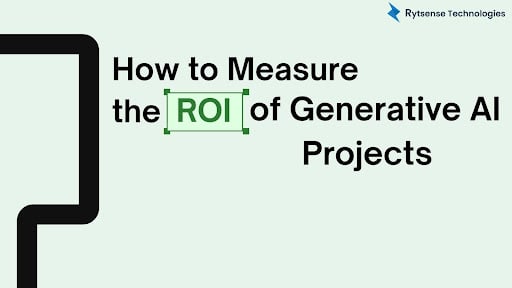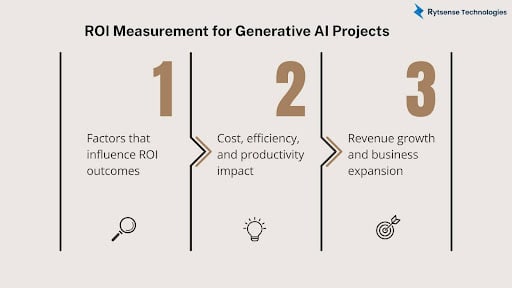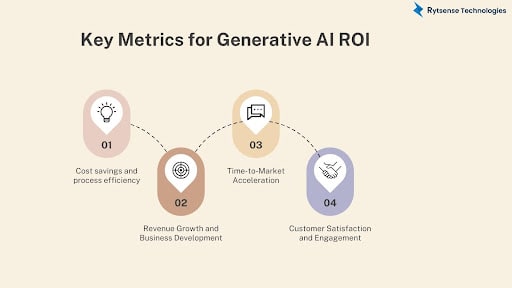ROI of Generative AI – How to Measure and Maximize It
Generative AI is transforming how businesses operate. Businesses of all kinds have turned to A.I. to generate content, assist customers and make work easier. But how can you tell if an investment in A.I. is worth it? This is where ROI comes in. Many organizations even consult the Best AI Development Company in USA to identify measurable value and maximize returns.
ROI is an acronym for Return on Investment. It allows you to see that the money you used on the item if it was worth it. For AI projects, ROI is very relevant, given that AI can be expensive to start and to operate.

Why ROI matters in Generative AI projects
When companies pay for AI, they want it to work well. ROI lets them know if their AI investment is performing well. Without real-time ROI measurement, companies could end up throwing money at AI systems that aren’t really boosting their performance.
Think of it as like buying a car. You want to find out if the car saves you money on gas or gets you to work faster. The same concept goes for AI; you have to know if it saves money or makes your business better.
Business impact of measuring AI investments
Calculating AI investments enables businesses to be intelligent about their choices. If you can identify which of your AI projects work best, you can invest more money in them. You can also avoid throwing cash at AI projects that don’t perform well.
When companies track the AI ROI, they tend to realize a better result. They can demonstrate that AI is making the business grow to their bosses and investors. This means it’s easier to raise more money for future AI projects.
Understanding the ROI of Generative AI
But first, let’s figure out how ROI of Generative AI is represented in the context of AI projects. Because AI can be a benefit in so many different ways, Generative AI ROI isn’t like other business investments.
What is Generative AI ROI?
ROI of Generative AI is how much value you receive from your investment in AI, versus what you spent. It examines not just the money you save, but the additional money you make thanks to AI.
A good benchmark will be what percentage they save, and effective AI should always be able to save more than it costs.” For instance, if you’ve spent $10,000 on an AI writing tool and it helps you save $15,000 by getting your team to work faster, your ROI is positive. You received more than you paid for.
There are many ways that AI value can be driven. It could draft emails, compose pictures, respond to customer queries or assist with research. All of these opportunities offer a potential time and money savings for your business.
enefits to Assessing ROI for AI Projects
Assessing ROI benefits you in three ways. First, it will assess the best AI tools for your organization. Second, it will provide you with insight to explain the value of AI to others. Finally, it will assist in making quality decisions in the future regarding investing in AI technology.
Determining ROI of Generative AI is also great to identify issues early. If the AI project is not yielding value for your organization, you can either fix it or walk away before making too much of a financial commitment.
Want to unlock measurable value from Generative AI? Partner with experts who can align AI with your business goals.

How to Calculate ROI of Generative AI
Calculating ROI of Generative AI sounds complicated, but it is not as complex as it may sound and can be simple when divided into parts.
ROI Calculation Formula for AI Projects
To capture return on investment for an AI initiative, use this formula:
ROI = (Benefits - Costs) ÷ Costs × 100
Benefits can be quantified savings, additional revenue, or efficiencies redeeming time. Costs aggregate spend on AI subscriptions, user training, and the hours staff invest. Over 12 months, it frees a equivalent of 8,000 hours of employee time by expediting answers to routine inquiries. The ROI reads:
ROI = ($8,000 - $5,000) ÷ $5,000 × 100 = 60%
A 60% return signals the project delivered 60% extra financial upside against the initial expenditure.
Direct vs Indirect Value Measurement
Direct value easily translates into dollars, featuring quantifiable payroll savings, lower software licensing, and incremental sales the AI generates from responsive interactions.
Indirect value, by contrast, is tougher to enumerate, yet real. Happier customers who broadcast endorsements, more engaged staff who avert burnout, and an elevated brand reputation collectively amplify the bottom line. Assigning precise dollar equivalents to these effects remains optional but insightful, reinforcing the case for AI investment.
Industry-specific calculation examples
Every industry measures AI return on investment differently. A retail business may only consider the increase in sales resulting from AI recommendations. A manufacturer may develop their return on investment by measuring the time saved with production planning. Health care organizations usually look at how AI adoption will positively impact patient care, and law firms may assess the value of the AI in speeding up how lawyers can research cases. Each industry will have its own relevant measures.
Read More:
What Is AI in Software Development?ROI Measurement for Generative AI Projects
The following variables can influence how much return on investment you get from an AI project. Understanding some of these variables can help you make better choices.

Factors that influence ROI outcomes
There are many variables that can affect the return on your AI project. First, the magnitude of your data's quality. AI technology works best given good, clean data to work.
Also, your staff's capabilities are important. If your staff can use AI technology (like ChatGPT) effectively, it will yield positive results. Often, training the staff is a critical piece to realize for AI.
Some tech works better than others based on what you want to do. Choosing the right tools to fit or set your needs is very crucial.
Cost, efficiency, and productivity impact
In general, AI can help your business in three ways. First, it can cut costs by taking processes away from people and automating them. Second, it can increase efficiency in existing processes. Third, it can create team productivity.
For example, an AI writing assistant may help your marketing team produce content faster. That means they could produce faster the same amount of content with their work time.
Revenue growth and business expansion
AI can also help you make more money by improving customer experience. AI chatbots can provide answers to customers' questions 24/7. AI recommendation engines can recommend products customers may to purchase.
When customers receive better experiences, they are more likely to purchase from you again. And they may even tell their friends about your company, creating new customers.
Not sure which AI projects bring the most ROI? Get a tailored strategy designed for your industry.

Key Metrics for Generative AI ROI
If you want to measure your ROI of Generative AI, be sure to track and use the right metrics. Every business will focus on varied metrics, depending on its objectives.

Cost savings and process efficiency
One of the more clear metrics to measure is cost reduction, that includes labor cost reductions, software cost reductions, & operational cost reductions.
Operational efficiency metrics demonstrate the means by which AI makes your work faster or better. This could involve reductions in steps or process times, reductions in errors or mistakes or improvements in the quality of the output you provide.
Revenue Growth and Business Development
Revenue metrics describe means by which AI allows you to make more money, whether that's by generating more sales, offering a different product, or developing or exploring new markets.
AI may allow you to serve (or serve more) customers without hiring additional staff, or it may enable you to offer completely new services that you necessarily could not have offered.
Time-to-Market Acceleration
AI can also help reduce time to market for your products or services. Any time you can bring a product or service to market faster, is beneficial, especially when there is competition and being first can be a major advantage.
For example, AI may assist you in developing marketing collateral in less time, allowing you to bring a marketing campaign to market sooner than your competition, and survive much longer in a competitive environment.
Customer Satisfaction and Engagement
Satisfied customers are worth plenty to your business. AI can support your customer satisfaction through timeliness, quality recommendations and better experiences (including personalized experiences).
Customer satisfaction can be measured through survey responses, reviews or ratings, and repeated purchases.
Challenges in Measuring Generative AI ROI
Calculating the ROI of AI isn't necessarily straightforward; there are a number of common challenges that organizations can face.
Data availability and quality issues
In order to accurately measure ROI, you'll need data. However, in many cases organizations either don't have all of the data they need or their data isn't very reliable.
You need data, preferably from before you started using AI, to compare to post AI deployment data and that earlier baseline is key to understanding what benefit you have gained from AI.
Defining success metrics
Different people in your organization might have different opinions as to what defines success. The marketing team may be concentrating on lead generation, while the finance team is focused on the impact to their cost reduction.
Please make sure everyone is aligned on what you are going to measure when you launch your AI program.
Long-term vs short-term ROI evaluation
Some benefits of AI initiatives will come quickly, others will take months or years prior to realizing any benefits. Short-term ROI is easier to measure, but the long-term gains may be more valuable.
As an example, customer satisfaction may be higher after deploying AI, which does not immediately increase sales, but will likely turn into loyalty purchases for that brand sooner or later.
Hidden costs and compliance factors
AI projects can sometimes have hidden costs that may be overlooked. These may be in the form of training costs, integration costs, or ongoing maintenance costs. In some industries, there is a compliance obligation that can add additional costs to AI projects. For example, healthcare and finance companies need to be especially careful with data privacy and compliance.
Generative AI ROI Calculators and Frameworks
There are various tools and frameworks that can make estimating AI ROI much easier.
Popular ROI calculation models
There are several different standard models that you can use to estimate AI ROI. The Total Economic Impact (TEI) model looks at all costs and costs over a specified period of time. The Net Present Value (NPV) model looks at the effect of the time value of money.
The key takeaway is to identify a model that works for your business and be consistent, so you can reasonably compare different AI projects.
Tools and platforms for ROI analysis
There are many software tools that you can use to track and estimate AI ROI. Some of these are simple spreadsheet templates while others are complex business intelligence platforms. Some of the most common are Microsoft Excel templates, Google Analytics for web-based AI, AI ROI calculators from consulting firms.
Building a custom ROI framework
There may be times when you want to build your own ROI framework which may address your business's needs specifically. Building a custom framework means you must identify your specific costs and benefits to your organization and then create a system to measure and track those costs and benefits over time. While generating a custom framework takes more time to build, it may ultimately lead to more precise and applicable measurements.
Future of ROI in Generative AI
AI technology is changing rapidly and so is how we can measure its value.
Emerging trends shaping AI ROI
New AI capabilities uniquely create unique measures of value. Artificial intelligence with capabilities of handling increasingly complex tasks may pose ROI opportunities which differ from previous capabilities, such as automation.
The cost of Artificial Intelligence is changing. As AI continues to get less expensive and easier to own and operate, the costs related to ROI change as well.
Role of Generative AI in business automation
AI is getting better at automating various complex business processes. This represents new opportunity for ROI to not only be calculated in unit measure but other quantifiable measurements.
As AI begins to perform higher-value strategic tasks, it becomes increasingly difficult to identify its benefits while representing its intrinsic true value.
Predictive ROI for scaling AI adoption
Predictive analytics are enabling us to understand the potential ROI of new AI projects and comparing it with historical ROIs associated with previous projects. Historical data about what costs and benefits occurred combined with future predictive work can support organizations as they reset their AI strategy.
Predictive ROI can also identify business functions where AI investment will yield the highest potential returns.
Conclusion
It is critical to establish measurable ROI for generative AI projects in order to make business successful. Although it is often a difficult task, following the appropriate process will make it less overwhelming and worthwhile. If you are unable to follow this, you can get in touch with Rytsense Technologies now.
How businesses can maximize ROI from AI investments
To maximize ROI from AI, select projects that fit your overall strategic direction. Put money in training and have good data quality to ensure appropriate functionality.
Plan small pilot projects to discover what works before you scale. The repetition of measuring and adjusting proves to ensure your AI investment continues to add value.
Understand that measuring AI ROI is not a one-time calculation; it is a continuous effort. Your business and AI technology are dynamic, and as they renew, your way of measuring value should refresh.
As long as you plan and measure carefully, generative AI can deliver substantial returns on investment and change how your business executes.
Generative AI can deliver exponential returns—if implemented strategically. Let’s help you maximize ROI from every project.


The Author
Karthikeyan
Co Founder, Rytsense Technologies